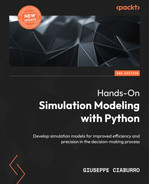Learn to construct state-of-the-art simulation models with Python and enhance your simulation modelling skills, as well as create and analyze digital prototypes of physical models with ease Simulation modelling is an exploration method that aims to imitate physical systems in a virtual environment and retrieve useful statistical inferences from it. The ability to analyze the model as it runs sets simulation modelling apart from other methods used in conventional analyses. This book is your comprehensive and hands-on guide to understanding various computational statistical simulations using Python. The book begins by helping you get familiarized with the fundamental concepts of simulation modelling, that’ll enable you to understand the various methods and techniques needed to explore complex topics. Data scientists working with simulation models will be able to put their knowledge to work with this practical guide. As you advance, you’ll dive deep into numerical simulation algorithms, including an overview of relevant applications, with the help of real-world use cases and practical examples. You'll also find out how to use Python to develop simulation models and how to use several Python packages. Finally, you’ll get to grips with various numerical simulation algorithms and concepts, such as Markov Decision Processes, Monte Carlo methods, and bootstrapping techniques.
By the end of this book, you'll have learned how to construct and deploy simulation models of your own to overcome real-world challenges. This book is for data scientists, simulation engineers, and anyone who is already familiar with the basic computational methods and wants to implement various simulation techniques such as Monte-Carlo methods and statistical simulation using Python.Key Features
Book Description
What you will learn
Who this book is for
Table of Contents
- Hands-On Simulation Modeling with Python
- Contributors
- About the author
- About the reviewer
- Preface
- Part 1:Getting Started with Numerical Simulation
- Chapter 1: Introducing Simulation Models
- Chapter 2: Understanding Randomness and Random Numbers
- Chapter 3: Probability and Data Generation Processes
- Part 2:Simulation Modeling Algorithms and Techniques
- Chapter 4: Exploring Monte Carlo Simulations
- Chapter 5: Simulation-Based Markov Decision Processes
- Chapter 6: Resampling Methods
- Chapter 7: Using Simulation to Improve and Optimize Systems
- Chapter 8: Introducing Evolutionary Systems
- Part 3:Simulation Applications to Solve Real-World Problems
- Chapter 9: Using Simulation Models for Financial Engineering
- Chapter 10: Simulating Physical Phenomena Using Neural Networks
- Chapter 11: Modeling and Simulation for Project Management
- Chapter 12: Simulating Models for Fault Diagnosis in Dynamic Systems
- Chapter 13: What’s Next?
- Index
- Other Books You May Enjoy
